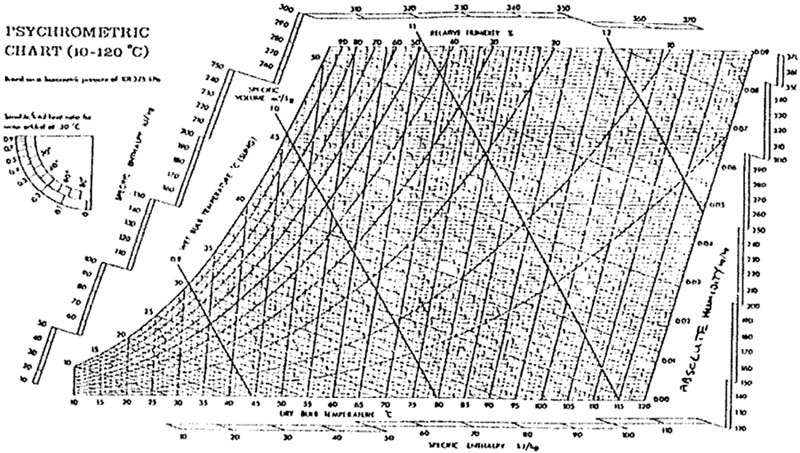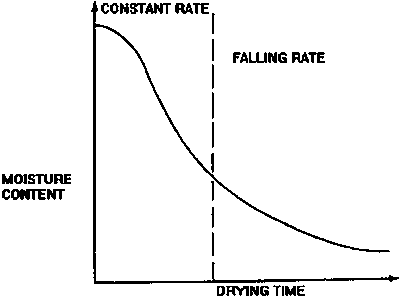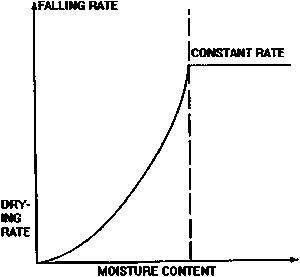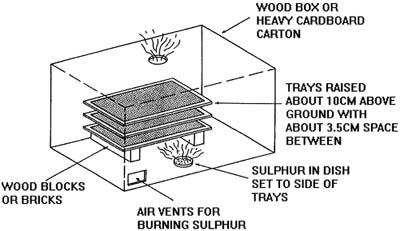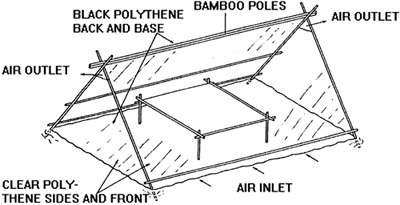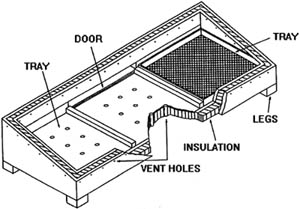Comment conserver les aliments par le séchage
Sommaire
Le séchage des aliments – Fiche technique
Le séchage des aliments
Le séchage est utilisé pour enlever l'eau à partir d'aliments pour deux raisons: pour éviter (ou inhiber) les micro-organismes et donc conserver les denrées alimentaires et à réduire le poids et le volume de nourriture pour des transports et stockage moins chers.
Lorsque cela est effectué correctement, la qualité nutritionnelle, la couleur, la saveur et la texture des aliments réhydratés sont un peu moins élevée que les aliments frais, mais, pour la plupart des gens, cela n'a qu’une légère importance nutritionnelle comme les aliments séchés forment une composante du régime alimentaire.
Toutefois, si le séchage est effectué à tort il y a une perte plus grande des qualités nutritionnelles et alimentaires et plus sérieusement, un risque d'altération microbienne et peut-être encore de l'intoxication alimentaire.
Cette note technique décrit donc certaines des conditions requises pour un bon séchage et synthétise des informations sur les différents équipements de séchage disponibles.
Le séchage peut être effectué à l'aide d'air chaud ou, moins fréquemment, par des casseroles en métal chaud. La dernière étape de prise de gari est un exemple de séchage à l'aide de métal chaud mais dans cette note technique, nous nous concentrerons sur le séchage à l'air chaud.
Pour un séchage efficace, l'air doit être chaud, sec et en mouvement. Ces facteurs sont liés entre eux et il est important que chaque facteur soit correct (par exemple, le déplacement d'air froid ou chaud, l'air humide en mouvement est insatisfaisant). La sécheresse de l'air est appelée «l'humidité» - la baisse de l'humidité, le plus sec de l'air. Il y a deux manières d'exprimer l'humidité (ou RH), la plus utile est le rapport entre la vapeur d'eau dans l'air à l'air qui est complètement saturé d'eau. Ce que le 0% d'humidité relative de l'air est complètement sec et 100% d'humidité relative est une atmosphère qui est totalement saturé en vapeur d'eau.
Un faible RH (ou sec) de l'air doit être soufflée sur les aliments de sorte qu’il a la capacité de récupérer la vapeur d'eau de la nourriture et de la supprimer. Si un RH élevé (ou humidité) d'air est utilisé, il devient rapidement saturé et ne peut pas capter la vapeur d'eau de la nourriture.
La température de l'air affecte le taux d'humidité (une température élevée réduit l'humidité et permet à l'air de transporter plus de vapeur d'eau). La relation entre la température et le RH est bien indiqué sur un tableau psychrométriques, figure 1.
Notez qu'il existe deux types de température de l'air:
La température de l'air, mesurée par un thermomètre, on appelle la température du thermomètre sec. Si le thermomètre est entouré d'un linge humide, la chaleur est éliminée par l’évaporation de l'eau de la nappe et la température chute (thermomètre humide). La différence entre les deux températures est utilisée pour trouver l'humidité relative de l'air de la carte psychrométrique.
Le point de rosée est la température à laquelle l'air est saturé d'humidité (100% RH) et de tout refroidissement supplémentaire à partir de ce point les résultats de la condensation de l'eau de l'air. Cela se voit dans la nuit lorsque l'air se refroidit, forme de la vapeur d'eau comme la rosée sur le sol. Les lignes de refroidissement adiabatique sont les lignes droites parallèles inclinées à travers le tableau, qui montrent comment l'humidité absolue baisse pendant que la température de l'air augmente.
Le tableau psychrométrique est utile pour trouver les changements dans l'air pendant le séchage et, par conséquent, l'efficacité d'un séchoir. Les exemples suivants montrent comment il est utilisé.
En utilisant la figure 1, trouvez:
1. le taux d'humidité absolue de l'air qui compte 50% d'humidité et une température avec thermomètre sec de 60°C
2. la température avec thermomètre humide, dans ces conditions
3. l'humidité relative de l'air ayant une température avec thermomètre humide de 45°C et une température avec thermomètre sec de 75°C
4. le point de rosée de l'air refroidi à une température adiabatique du thermomètre sec de 55°C et 30% RH
5. le changement en RH de l'air avec une température avec thermomètre humide de 39°C, chauffée à partir d'une température avec thermomètre sec de 50°C à une température du thermomètre sec de 86°C
6 le changement en RH de l'air avec une température avec thermomètre humide de 35°C, à refroidissement adiabatique à partir d'une température du thermomètre sec de 70°C à 40°C.
Réponses
1. 0,068 kg par kilogramme d'air sec (trouvez l'intersection des lignes entre 60°C et 50% RH, puis suivez le tableau horizontalement droit et lisez l'humidité absolue)
2. 246.5°C (à partir de l'intersection des lignes entre 60°C et 50% allez à gauche parallèlement aux lignes de thermomètre d'humidité pour lire la température de thermomètre humide)
3. 20% (trouvez l'intersection des lignes entre 45°C et 75°C et suivez la ligne oblique vers le haut pour lire le % de RH)
4. 36°C (trouvez l'intersection des lignes entre 55°C 55 et 30% RH et suivez la ligne du thermomètre humide à gauche jusqu'à ce que le RH atteigne 100%)
5. 50-10% (trouve l'intersection entre le thermomètre humide de 39° et le thermomètre sec de 50°C et suivez la ligne horizontale jusqu'à l'intersection avec le thermomètre sec de 86°C, lisez la ligne descendante RH à chaque intersection (ce qui représente les changements qui se produisent quand l'air est chauffé avant d'être soufflé sur l'alimentation))
6. 10-70% trouvez l'intersection entre le thermomètre humide de 35°C et s thermomètre sec de 70°C et suivez la ligne du thermomètre humide à gauche jusqu'à l'intersection avec le thermomètre sec de 40°C; lisez la ligne descendant du RH à chaque intersection (ce qui représente les changements en cours lorsque l'air est utilisé pour sécher la nourriture, l'air se refroidit et devient plus humide car il capte l'humidité de la nourriture). Si un nouveau type de séchoir doit être utilisé, ou si un autre type de nourriture doit être séchée, il est nécessaire de faire quelques essais pour trouver la vitesse de séchage. L'information peut ensuite être utilisée pour trouver le temps que les aliments doivent passer dans le séchoir avant que la teneur en humidité soit suffisamment faible pour empêcher la détérioration par les micro-organismes. Le taux de séchage a également un effet important sur la qualité des aliments séchés (par les séchoirs artificiels) et la consommation de carburant. Pour trouver la vitesse de séchage, vous aurez besoin d'une horloge / montre et un ensemble d'échelles. La nourriture est pesée, placée dans le séchoir pendant 5 à 10 minutes. Elle est ensuite retirée, repesée et remplacée. On continue jusqu'à ce que le poids de l'aliment ne change plus. L'intervalle entre les pesées peut être augmenté lorsque les changements de poids deviennent minimes. Vous devriez également prendre note de la température du thermomètre humide et sec de l'air à l'intérieur du séchoir et de l'air à l’extérieur. Les résultats sont reportés sur un graphique (figure 2) et montrent deux phases distinctes de séchage - la «constante» et les périodes de taux descendant. Dans la constante le taux de la surface de l'aliment reste humide et il peut donc être gâté par des moisissures et des bactéries. Dans la baisse du taux, la surface est sèche et le risque de détérioration est beaucoup plus petit. Les aliments doivent donc être séchés pour un poids qui correspond à la fin de la période constante le plus rapidement possible (voir toutefois la «cémentation» ci-dessous)
<center>
Les informations à partir d'une expérience peut être plus utiles comme le montre la figure 3, en calculant le taux de séchage pour chaque période de 10 minutes, comme suit:
La teneur en humidité à la fois des aliments frais et des denrées alimentaires finales séchées peut être trouvé par la pesée des aliments, en les chauffant à 100°C dans une étuve pendant 24 heures et en les repesant. La teneur en humidité est trouvée ainsi:
D'autres valeurs de l'humidité pendant la période de séchage peuvent être trouvées par ces deux résultats relatifs au poids des denrées alimentaires enregistrées durant l'essai de séchage et en appliquant des facteurs similaires à des poids intermédiaires. La figure 3 donne deux informations importantes:
1. Le taux de séchage réel au cours de la période de taux constant qui démontre l'efficacité du séchoir
2. La teneur en humidité finale de la nourriture sèche qui démontre qu’elle restera stable pendant le stockage.
Généralement, un taux de séchage de 0.25kg/hr serait attendu pour séchoirs solaires en fonction de la conception et le climat, et 10-15kg/hr relatives aux séchoirs artificiels. Pour assurer un stockage sûr la teneur en humidité finale de l'aliment devrait être inférieure à 20% pour les fruits et la viande, moins de 10% pour les légumes et 10-15% pour les céréales.
Si le taux de séchage est inférieur à cela, la température de l'air ou la vitesse est trop faible et / ou l'humidité relative est trop élevée. Ceci peut être vérifié par les mesures de température faite au cours de l'expérience et en utilisant le tableau psychrométrique. Normalement, l'air dans le séchoir devrait être de 10-15ºC au dessus de la température ambiante dans des séchoirs solaires et de 60-70°C dans les séchoirs artificiels. Le RH d'air entrant dans le séchoir variera en fonction des conditions locales, mais devrait idéalement être inférieur à environ 60% RH.
La stabilité d'un aliment sec pendant l'entreposage dépend de sa teneur en humidité et la facilité avec laquelle les aliments peuvent prendre l'humidité de l'air. Il est clair que les risques d'humidité sont plus élevés dans les régions de forte humidité. Toutefois, différents aliments se chargent d'humidité à des degrés différents (à comparer par exemple l'effet d'une forte humidité sur le sel ou le sucre avec l'effet sur le poivre en poudre. Le sel et le sucre se chargent d'humidité tandis que le poivre ne prend pas l’humidité).
Pour les aliments qui prennent facilement l'humidité, il est nécessaire de les emballer dans un matériau résistant à l'humidité.
Un faible taux d'humidité est seulement une indication de la stabilité des denrées alimentaires et non une garantie. Elle est la disponibilité d'humidité pour la croissance microbienne qui est plus important et le terme «Activité de l'eau (AWA) est utilisé pour décrire cela. L’activité de l'eau varie de 0-1.00 et moins il y a de valeur, plus il est difficile pour les micro-organismes de se développer sur un aliment.
Exemples de teneurs en humidité et des valeurs AW de certains aliments et leurs conditions d'emballage sont indiqués dans le tableau 1.
|
Food |
Moisture content % |
Water activity |
Degree of protection required |
|
Fresh meat |
70 |
0.985 |
Package to prevent moisture loss |
|
Bread |
40 |
0.96 |
. |
|
Marmalade |
35 |
0.86 |
. |
|
Rices |
15-17 |
0.80 |
Minimum protection or no packaging required |
|
Wheat flour |
14.5 |
0.72 |
. |
|
Raisins |
27 |
0.60 |
. |
|
Macaroni |
10 |
0.45 |
. |
|
Marzipan |
15-17 |
0.75 |
. |
|
Oats |
10 |
0.65 |
. |
|
Nuts |
18 |
0.65 |
. |
|
Toffee |
8 |
0.60 |
Packaged to prevent moisture dried uptake |
|
Cocoa powder |
0.40 |
. |
. |
|
Boiled sweets |
3.0 |
0.30 |
. |
|
Biscuits |
5.0 |
0.20 |
. |
|
Milk |
3.5 |
0.11 |
. |
|
Potato crisps |
1.5 |
0.08 |
. |
|
Spices |
5-8 |
0.50 |
. |
|
Dried vegetables |
5 |
0.20 |
. |
|
Breakfast cereal |
5 |
0.20 |
. |
Table 1: Food Type characteristics and packaging requirements
Case hardening and other effects of drying
Case hardening is the formation of a hard skin on the surface of fruits, fish and some other foods which slows the rate of drying and may allow mould growth. It is caused by drying too quickly during the initial (constant rate) period and can be prevented by using cooler drying air.
Other changes to foods include colour loss, flavour loss and hardening. Experiments with air temperature and speed can be used to select the best conditions for each food. The colour of many fruits can be preserved by dipping in a solution of 0.2-0.5% sodium metabisulphite or by exposing to sulphur dioxide in a sulphuring cabinet, Figure 4.
Vitamin losses are often greater during peeling/slicing etc than during drying. Loss of fat soluble vitamins can be reduced by shade drying and loss of water soluble vitamins by careful slicing using sharp knives. Blanching of vegetables is necessary before drying and water soluble vitamins are also lost in this stage. It should be noted that drying does not destroy micro-organisms and only inhibits their growth.
So heavily contaminated fresh foods will become heavily contaminated dried and rehydrated foods. Blanching is one method of reducing the levels of initial contamination. Thorough washing of fresh foods should be done routinely before drying.
Summary of small-scale drying equipment available
Solar driers
Solar drying is popular with agencies and research stations. However, there are no small-scale solar driers that are yet operating economically. There are a number of reasons for this:
- The amount of food lost in traditional drying is often over estimated (people report the worst case and the average amount)
- The loss of quality is not necessarily reflected in lower prices. People are willing to pay nearly the same amount for discoloured or damaged foods and there is therefore no incentive for producers to risk higher amounts of money in a drier when there is not a great return
- Different quality standards are applied by agencies and rural people. It is not necessary to achieve export quality for sale in rural areas
- Driers are only needed in villages if the weather is unsuitable for traditional methods. If these conditions are not very common, the drier will not be needed. Even short periods of sunshine are enough to prevent serious crop losses. Some producers wait for sunshine rather than risk the expense of using a drier. The food is then either spoiled or the drier is not big enough to handle the amounts involved
- Other methods are available to preserve the food if it rains during harvest, for example the harvest can be delayed, food can be stacked in a way which prevents it from getting wet, or small amounts can be dried over a kitchen fire, or mixed with dry crop
- Some benefits of proper drying (for example absence of mould, and better milling characteristics of grains) cannot be seen and there is therefore no increase in value of the food
Other disadvantages of both solar and mechanical driers include greater space and labour requirements than traditional methods (for example loading, unloading of trays). These costs are given lower value by agencies than by villagers.
Solar driers operate by raising the temperature of the air to between 10-30ºC above room temperature. This makes the air move through the drier and also reduces its humidity.
There are advantages to solar drying as follows:
The higher temperature, movement of the air and lower humidity, increases the rate of drying. Food is enclosed in the drier and therefore protected from dust, insects, birds and animals. The higher temperature deters insects and the faster drying rate reduces the risk of spoilage by micro-organisms. The higher drying rate also gives a higher throughput of food and hence a smaller drying area. The driers are water proof and the food does not therefore need to be moved when it rains. Driers can be constructed from locally available materials and are relatively low cost.
Designs vary from very simple direct driers (for example a box covered with plastic to trap the sun's heat) to more complex indirect designs which have separate collectors and drying chambers. The most common type of collector is a bare galvanised iron plate which is painted matt black. These give a temperature increase of 10ºC and increases the air speed to about 5m/s. Other types include burnt rice husks or charcoal.
The collectors are covered with a transparent material to ensure uniform airflow. Glass covers are best but they break easily, are heavy and expensive. Plastic often has poor stability to sunlight and weather, but is about 10% of the weight of glass and does not break. The best types of plastic are polyester and polycarbonate when available. Polythene is cheaper and more widely available but is not as strong and is less resistant to damage by light and weather.
The food can be either exposed to the sunlight (in direct systems) or heated air is passed over shaded food in indirect systems. Direct systems are used for food such as raisins, grains and coffee where the colour change caused by the sun is acceptable, but most foods need indirect systems to protect the colours in the food. Other types of driers use fans to blow the air over the food but this adds to the capital and operating cost and removes the advantages of driers in rural areas which can not operate without electricity.
There are three basic types of drier, each of which has many variations. 1, tent driers (direct), 2, cabinet driers (direct or indirect) and 3, chimney driers (indirect). Each of these types uses natural air circulation although it is possible to fit an electric or wind powered fan to increase the speed of the air.
Tent drier - Figure 5
This type consists of a ridge tent framework, covered in clear plastic on the ends and the side facing the sun, and black plastic on the base and the side in shade. A drying rack is placed along the full length of the tent. The bottom edge of the clear plastic is rolled around a pole, which can be raised or lowered to control the flow of air into the drier. Moist air leaves through holes in the top corners of the tent.
The advantages of this type of drier are the low construction costs and simplicity of operation. However, like other types of solar drier, there is relatively poor control over the RH of the air in the drier and so, poor control over drying rates. It is also lightweight and fairly fragile when moved or in windy conditions.
Cabinet drier - Figure 6
The basic design is an insulated rectangular box, covered with clear glass or plastic. There are holes in the base and upper parts of the box to allow fresh air to enter and moist air to leave. The inside of the cabinet is painted black to act as a solar collector. In indirect types, a flat plate is painted black and suspended in a insulated frame. Air is heated on both sides of the plate before passing into the drying cabinet. Food is placed on perforated trays within the cabinet and warm air from the collector rises up through the food and leaves through the top. The length of the cabinet is approximately three times the width to prevent shading by the sidewalls.
The sides can be made from board or mud-coated basket work. Larger models can be made from mud, brick or cement. The insulation can be wood shavings, sawdust, coconut fibre, dried grass or leaves, but should be at least 5cm thick to keep the inside temperature high. If insects are a problem, the air holes should be covered with mosquito netting. Drying trays should be made from basket work or plastic mesh. Metal should not be used as it can react with the acids in fruits and some vegetables and cause off-flavours in the food. These type of driers are used for fish, fruit, vegetables, root crops and oilseeds. They have capacities of up to 1 tonne.
Chimney drier
This is a modified cabinet drier in which a solar collector of black plastic or burnt husks is covered by clear plastic on a wooden framework. A black plastic chimney heats up the air above the exit to the drier and therefore increases the airflow through the drier.
Artificial (mechanical) drier
These use fuel to increase the air temperature, and reduce the RH and fans to increase air speed. They give close control over the drying conditions and hence produce high quality products. They operate independently of the weather and have low labour costs. However, they are more expensive to buy and operate than other types of driers. In some applications, where consistent product quality is essential, it is necessary to use mechanical driers.
Light bulb drier
This consists of an electric light bulb inside a wooden box. If electricity is available this is a simple, low cost drier which may be suitable for home preservation. The capacity is very small and it is not likely to be useful for income generation. The bottom of a box is painted black, or covered in soot or black cloth. The sides are covered in shiny material (for example aluminium paint) to reflect the heat onto the black surface. Air circulates by natural convection in a similar way to the solar cabinet drier, but in this case the drier can operate all night as well as all day.
Cabinet drier
The design is similar to the solar type but in this case the heat is supplied by burning fuel or electricity. If electricity is available, a fan can be used to increase the speed of air moving over the food and therefore increase the rate of drying. To be economical it is likely that this type of drier should be relatively large (1-5 tonnes). These are successfully used for drying herbs, tea and vegetables.
Practical Action has developed a range of drying systems including a small, low-cost industrial type which can be fabricated in countries of intended use. Its small size makes it suitable for decentralised use in crop-growing areas. The price at about US$ 3,000, is substantially lower than for standard, commercially available units.
The small unit is a semi-continuous drying cabinet with hot air supplied by an indirect heater-blower unit. Intended for round-the-clock operation, the semi-continuous tray drier is designed for maximum fuel efficiency. It takes about four hours for the first (bottom) tray to dry: after that, it can be removed, the remaining trays lowered, leaving a space at the top for a tray of fresh material. Trays can then be removed every twenty minutes.
Silo dryer
These driers consist of trays or tanks containing a deeper layer of food than those found in cabinet driers.
They have a larger capacity and are often used for grain drying, where the amount of water to be removed is smaller than for example fruits and vegetables, but the quantities involved are larger.
There is considerable scope for the use of small driers that combine the low cost of solar heating with better control of mechanical driers.
References and further reading
This Howtopedia entry was derived from the Practical Action Technical Brief Processing of Pepperâ€.
To look at the original document follow this link: http://www.practicalaction.org/?id=technical_briefs_food_processing
Anagi Tray Dryer, Practical Action Technical Brief
Drying of Apricots, Practical Action Technical Brief
Drying of Chillies, Practical Action Technical Brief
Drying Technologies, Practical Action Technical Brief
Solar Drying, Practical Action Technical Brief
Tray Dryers, Practical Action Technical Brief
Drying Food for Profit: A Guide for Small Businesses, Barrie Axtell, ITDG Publishing, 2002
Drying Foodstuffs: Techniques, Processes, Equipment, Jean-François Rozis, Backhuys Publishers, 1997
Producing Solar Dried Fruit and Vegetables for Micro-and Small-scale Rural Enterprise Development: A Series of Practical guides, Natural Resource Institute, 1996
Articles relatés
- Comment conserver les aliments par technologies de séchage à petite échelle
- Comment conserver les aliments par le séchage
- Comment utiliser l’énergie solaire
- Comment faire du chocolat
- Comment conserver les tomates
- Comment conserver les aliments avec un séchoir solaire
- Comment conserver et traiter les épices
- Comment traiter le curcuma
- Comment construire un séchoir à plateaux
- Le séchoir à plateaux Anagi
- Comment sécher les piments
- Comment traiter le poivre
Usefull addresses
Practical Action
The Schumacher Centre for Technology & Development, Bourton on Dunsmore, RUGBY, CV23 9QZ, United Kingdom.
Tel.: +44 (0) 1926 634400, Fax: +44 (0) 1926 634401
e-mail: practicalaction@practicalaction.org.uk
web: www.practicalaction.org

